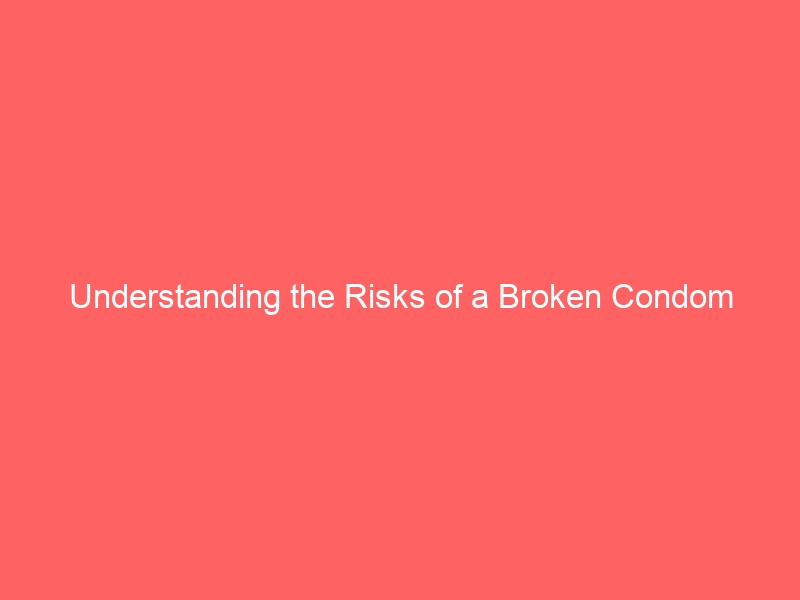When it comes to sexual health, understanding the risks associated with a broken condom is crucial. Many people don’t realize that when a condom breaks, it can lead to unintended pregnancies and the transmission of sexually transmitted infections. There are various factors that can contribute to condom malfunction, and being aware of these can help individuals make informed choices. Additionally, recognizing the signs of a broken condom can be essential for ensuring safety during intimate moments. By knowing what to do when a condom breaks and how to take preventive measures, individuals can better protect themselves and their partners.
Understanding Condom Breakage
Condom breakage can often occur due to improper usage or manufacturing defects. Many people don’t realize the importance of checking the expiration date before use. It’s also crucial that users apply the condom correctly to avoid slippage or tearing. Some individuals might not be aware that oil-based lubricants can weaken latex condoms, increasing the risk of breakage. Understanding these factors helps individuals make informed choices about their sexual health.
Potential Consequences of a Broken Condom
A broken condom can lead to unintended pregnancies and increase the risk of sexually transmitted infections. It can cause emotional distress for those involved, as uncertainty looms over their reproductive health. They may find themselves facing difficult decisions about pregnancy options. Additionally, there’s a heightened concern about the potential transmission of STIs, which can have long-term health consequences. Overall, the implications of a broken condom can significantly impact individuals’ lives.
Factors Leading to Condom Malfunction
Various factors can contribute to a condom malfunction, and many people might not be aware of them. It’s common for improper storage conditions to weaken the material. Additionally, using oil-based lubricants can lead to degradation of latex condoms. Some individuals might not check the expiration date, which can affect the condom’s integrity. Lastly, incorrect application techniques can result in slippage or breakage during use.
Signs of a Broken Condom
Signs of a broken condom include noticeable tears, unusual discomfort during use, or a lack of lubrication. It’s often recommended to inspect the condom before and after use for any visible damage. Users might experience a sudden change in sensation, indicating a potential issue. If there’s excessive friction or irritation, that could also signal a malfunction. Timely recognition of these signs can help prevent unwanted risks.
What to Do After a Condom Breaks
They should consider seeking emergency contraception as soon as possible. It’s important for them to assess the situation and determine if pregnancy prevention is needed. They might want to consult a healthcare professional for guidance on the next steps. Additionally, they should consider getting tested for sexually transmitted infections. Lastly, they can reflect on their contraceptive choices to prevent future incidents.
Preventive Measures for Safer Sex
Understanding preventive measures for safer sex helps individuals reduce the risk of unwanted outcomes. It’s essential to choose high-quality condoms and check their expiration dates before use. Regularly discussing sexual health and history with partners can enhance safety. Engaging in mutual monogamy or using additional contraceptive methods can further minimize risks. Lastly, staying informed about sexually transmitted infections (STIs) and getting tested regularly is crucial for overall well-being.
Frequently Asked Questions
What are the most common brands of condoms that users prefer?
When it comes to condom preferences, many users tend to gravitate towards a few well-known brands. Trojan is often cited as one of the most popular choices, offering a wide variety of options to suit different needs. Another favorite is Durex, which is recognized for its innovative designs and reliable quality. Lifestyles is also a common pick, especially among those looking for ultra-thin varieties. Some users might even prefer specialty brands like SKYN, which are made from polyisoprene for those with latex allergies. Ultimately, personal comfort and experience play significant roles in determining which brand individuals prefer.
How effective are different types of condoms in preventing stis?
Different types of condoms vary in their effectiveness at preventing STIs. Latex condoms are generally considered the most effective, as they provide a strong barrier against viruses and bacteria. Polyurethane condoms, while effective, might not fit as snugly and can be more prone to slippage. Polyisoprene condoms offer a latex-free alternative and also provide robust protection against STIs. However, lambskin condoms, although natural and comfortable, don’t protect against viral infections like HIV. It’s important for users to choose the right type of condom to ensure maximum protection during sexual activity.
Are there any cultural attitudes towards condom use that affect their popularity?
Cultural attitudes towards condom use can vary significantly across different societies, impacting their popularity. In some cultures, condoms are embraced as a responsible choice for safe sex, while in others, they might face stigma or resistance. Many individuals might associate condom use with promiscuity, leading to reluctance in discussing or using them. Additionally, education plays a crucial role; in regions where sexual health education is lacking, misconceptions about condoms can flourish. Campaigns promoting safe sex often need to navigate these cultural barriers to be effective. Ultimately, these attitudes influence not just the acceptance of condoms but also their accessibility and overall usage rates.
If you’re looking for innovative and discreet ways to carry condoms while ensuring your safety, I highly recommend checking out this informative page on creative ways to use a special container to carry a condom around. You’ll find practical tips that not only enhance convenience but also promote responsible practices. Visit this link to explore more: special container to carry a condom around.
